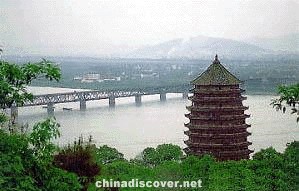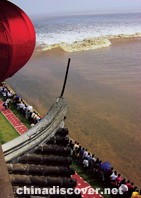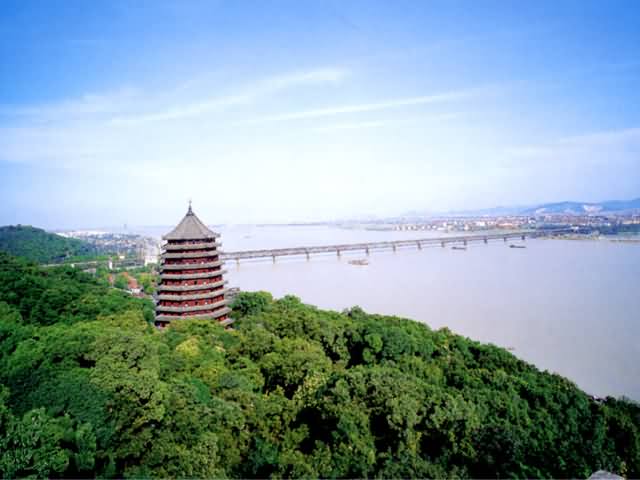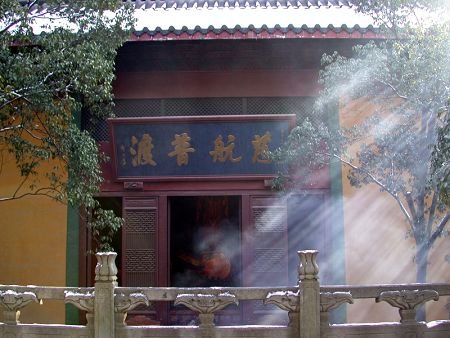Qiantang River

Overview
As the biggest in Zhejiang Province, Qiantang River runs from the west to Hangzhou Bay in the east. It serves as a river hinge, playing an important role in the water-transportation between the east and the west. It is encircled by a group of economically booming cities including Shanghai, China's leading industrial and commercial hub, and Ningbo, one of China's leading port cities. The extraordinary surging tide of the Qiantang River is a world-renowned natural wonder caused by the gravitational pull of the stars and planets. The centrifugal force produced by the rotation of the earth and by the peculiar bottleneck shape of Hangzhou Bay makes it easy for the tide to come in, but difficult for it to ebb.
Know more
Crossing the river is the Qiantang River Bridge. It is China's first self-designed and self-built bridge, which took from April 1934 to Sept 1937 to complete. Qiantang River Bridge is comprised of its main body and the bridge approach, stretching a distance of 1453 meters (4767 feet). It is also the first modern double - layer bridge in China. The upper layer of the bridge is highway and the layer below is railway. Qiantang River Bridge is designed by the famous Chinese bridge engineer Mao Yisheng, who defied the words spoken by foreigners that it was impossible to construct a bridge in such a spot, and who made a great contribution to the Chinese bridge building industry. Looking out from the Six Harmonies Pagoda, one can get a panoramic view of the mighty Qiantang River, the majestic Qiantang River Bridge, and the surrounding landscape.
Must see
The Tidal Bore Viewing Tradition
The tradition of witnessing the Qiantang River high tide began in the Han Dynasty (206 BC - AD220) and reached its height in the Song Dynasty (960-1279). It was during the Southern Song Dynasty (1127-1279) that the third day after the Mid Autumn Festival in latter half of September or early October, when the billows are at their most dynamic, was officially deemed the Tide Watching Festival.
There are two gushing tides nature phenomena in the world. One is in the mouth of the Amazon river in South America, another is in the Haining which is in the north bank of the Qiantang river. From 1st to fifth, fifteenth to twentyth every lunar month are great tides days. So you can view the tides in 120 days a year. On every 18th day of the 8th lunar month, the day is the 'viewing tides' day in Chinese custom.
The soaring tide of the Qiantang River is such a marvelous spectacle that only the Amazon River's surging tide rivals it! Annually, millions of people from both home and abroad flock there to watch the magnificent tide on the eighteenth day of the eighth lunar month (also around the Mid-Autumn Day). When the surging tide comes, the water can rise up to a height of 30 feet and the noise it generates sounds like thunder, or thousands of horses running. Various activities will also be held to celebrate the annual Tide - Watching Festival, according to local custom. In terms of its history, the custom of watching the bore tide has happened for more than 2000 years. It first appeared during the first century. Then, it became popular in the Tang  Dynasty (about 7th -13th century). Yangong town in Haijing 45 km (about 28 miles) from Hangzhou is the best place to watch the Qiantang Tide.
Dynasty (about 7th -13th century). Yangong town in Haijing 45 km (about 28 miles) from Hangzhou is the best place to watch the Qiantang Tide.
The rushing tide can be dangerous if you are careless.So it's best to listen to the advice of the local policemen there whose job it is to ensure your safety and security.
It was said the said the day is the god of tides' birthday. They will hold quite a few ceremonies for the birthday according to the local custom begging for the peace, placing their nice wishes on these. For a thousand years, the marvelous spectacle under heaven has attracted numberless famous people came to view the tides.
The best vantage point for high tide is Guanchang Shengdi (Tide Watching Wonderland) Park in Yanguan Town in the southwestern part of the city. The spectacle reaches its pinnacle, which lasts about 12 minutes, between 11 am and 2 pm. It starts as a white line on the horizon, and after a few seconds soars into a roaring rampart of water that towers as high as 3.5 meters. In some spots the fall of churning water that hits the embankment with a deafening crash is 8.9 meters. Despite punctilious security efforts on the part of the local government, a small number of ill advisedly adventurous spectators are swept away by the torrent every year.
Those that seek the full extent of the spectacle follow the tide by car from the Big Gap, 12 km east of Yanguan Town, to Yanguan, then westward to Yancang Town to see the waves return. Among these high tide devotees is Ding Zuguang. He has photographically recorded this phenomenon for 27 of his 61 years in Haining, and is obviously still thrilled at the memory of the largest bore he ever witnessed in the 1970s. He recalls: From a distance it looked like a mountain that seemed to block out the sky and earth. An unimaginable sight!
The downside of this natural wonder is that it constitutes a huge menace to life and industry. Haining locals built the Scale River Wall - a dyke constructed with bulky slates spliced to give the appearance of fish scales -- during the reign of Qing Emperor Qianlong (1736-1796), and it is as solidly secure today as ever. In 1998 the sloping embankment of the river was further reinforced in order to withstand the largest anticipated flood of the century.







